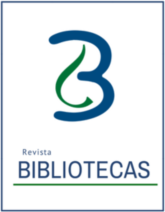A biblioteca: uma organização social complexa
Palavras-chave:
Biblioteca como organização social, planejamento da biblioteca, política de informação, capital social, gestão da informaçãoResumo
A biblioteca como organização social é afetada em seus níveis organizacionais, pois depende, na maioria dos casos, de uma instituição com missão e visão próprias. Ao mesmo tempo, rege-se por princípios teóricos e metodológicos da biblioteca que a transformam num sistema de informação. Por outro lado, os elementos intra-sociais e extra-sociais de uma forma ou de outra modificam não só o trabalho da biblioteca, mas também os planos de desenvolvimento da biblioteca, os programas particulares a implementar nos sistemas de biblioteca e os procedimentos internos, de modo a ter uma organização dinâmica e funcional que permita o acesso à informação solicitada pelos utilizadores. O objetivo deste artigo é rever quais são as características da biblioteca que a tornam uma organização complexa; quais são as inter-relações da biblioteca com os elementos intra-sociais e extra-sociais identificados; e como o capital social é construído em diferentes núcleos da sociedade através do acesso à informação.
Referências
Burnett, G. y Jaeger, P.T. (2008). Small worlds, life worlds and information: the ramification f the information behavior of social groups in public policy and the public sphere. Information Research, 13 (2). Disponible en: http://informationr.net/ir/13-2/paper346.html.
Burnett, G., Besant M. y Chatman E.(2001). Small worlds: normative behavior in virtual communities and feminist bookselling. Journal of the American Society for Information Science and Technology, 52(7). pp. 536-547.
Burnett, G., Jaeger, P.T. y Thompson, K.M.(2008). Normative behavior and information: the social aspects of information access. Library & Information Science Research, 30, pp. 56-66.
Chatman, E. A. (1985a). Low income and leisure: Implications for public library use. PublicLibraries, 24, pp. 34-36.
Chatman, E. A. (1985b). Information, mass media use and the working poor. Library & Information Science Research, 7, pp. 97-113.
Chatman, E. A. (1986). Diffusion theory: a review and test of a conceptual model in information diffusion. Journal of the American Society for Information Science and Technology, 37, pp. 377-386.
Chatman, E. A. (1987). Opinion leadership, poverty and information sharing. Reference Quarterly, 26, pp. 341-353.
Chatman, E. A. (1987). The information world of low-skilled workers. Library & Information Science Research, 9, pp. 265-283.
Chatman, E. A. (1990). Alienation theory: application of a conceptual framework to a study of information among janitors. Reference Quarterly,29, pp. 355-368.
Chatman, E. A. (1991). Channels to a larger world: older women staying in contact with the great society. Library & Information Science Research, 13, pp. 281-300.
Chatman, E. A. (1991). Life in a small world: application of gratification theory to information seeking behavior. Journal of the American Society for Information Science and Technology, vol.42: 438-449.
Chatman, E. A. (1996a). The impoverished world of outsiders. Journal of the American Society for Information Science and Technology.47, pp. 83-92.
Chatman, E. A. (1996b). Social context and culture: linking use and digital libraries. (1996). Digital Libraries Workshop. Disponible en: http://is.gseis.ucla.edu/research/dig_libraries/chatman.html.
Chatman, E. A. (1999). A theory of life in the round. Journal of the American Society for Information Science and Technology, 50, pp. 207-217.
Chatman, E. A. y Pendleton, V. (1995). Knowledge gap, information seeking behavior and the poor. Reference Librarian, 49-50, pp. 135-145.
Galbraith, J.y Lawler,E. (1993). Organizing for the future: the new logic for managing complex organizations. San Francisco, California : Jossey-Bass.
Galbraith, J. (1973). Designing complex organizations. EE.UU : Addision Wesley.
Galbraith, J. (2002). Designingorganizations: an executive guide to strategy, structure and process. San Francisco, California :Jossey-Bass.
International Federation of Library Associations. (2007). Manifiesto sobre el internet de la IFLA. IFLANET. Disponible en:http://archive.ifla.org/III/misc/im-s.htm.
International Federation of Library Associations. (2008). Manifiesto IFLA por la Biblioteca Multicultural. Disponible en: http://archive.ifla.org/VII/s32/pub/MulticulturalLibraryManifesto-es.pdf
International Federation of Library Associations. (XXXX). Manifiesto UNESCO/IFLA sobre bibliotecas escolares. Disponible en: http://www.unesco.org/webworld/libraries/manifestos/school_manifesto_es.html.
Kickert, W.(1983). Research note: research models underlying situational dependency.Organization Studies,4(1), pp. 55-72.
Lakos, A. (1999). The missingingredient –culture of assessment in libraries. Performance Measure and metrics.Sample Issue, pp. 3-7.
Luckmann, B. (1970). The small life-world of modern man. Social Research, 3, pp. 580-596.Stamper, R. (1988). Analyzing the cultural impact o a system. International Journal of Information Management,8, pp. 107-122.
Tolbert, P. S. y Hall, R. H. (2009). Organizations: structures, processes and outcomes. 10 ed. New Jersey, EE.UU, Pearson-Prentice Hall.
Unruh, D. (1980). The nature of the social worlds. Pacific sociological Review, 23(3), pp. 271-296.
Urry, J. (2005). The complexities of the global. Theory, Culture and Society, 22 (5), pp. 235-254.
Urry, J. (2005). The complexity turn. In Theory, Culture and Society, 22(5), pp. 1-14.
Downloads
Publicado
Como Citar
Edição
Seção
Licença
Bibliotecas proporciona acceso abierto inmediato a sus contenidos, basándose en el principio de facilitar la investigación al público de manera gratuita y libre para favorecer el intercambio global del conocimiento.
La revista Bibliotecas es una publicación acogida por una institución de educación superior pública, la cual, es sustentada por recursos públicos. Desde sus inicios, la revista ha ofrecido todos sus contenidos de forma gratuita sin ninguna restricción a los derechos de: lectura, descarga e impresión a texto completo. Los trabajos publicados en Bibliotecas pueden ser analizados, citados y reproducidos total o parcialmente, mencionando la fuente original.
La revista Bibliotecas está bajo la licencia de Creative Commons Reconocimiento – No Comercial – Compartir Igual, 4.0 Internacional; por lo que se permite: compartir, copiar y redistribuir el material en cualquier medio o formato.

Este obra está bajo una licencia Creative Commons Atribución-NoComercial-CompartirIgual 4.0 Internacional.






